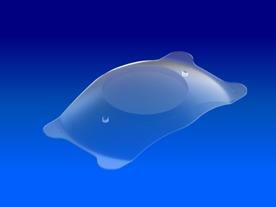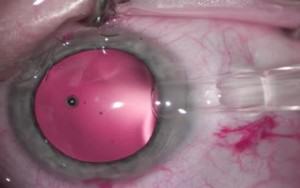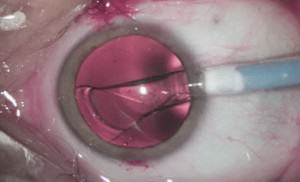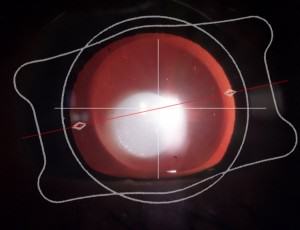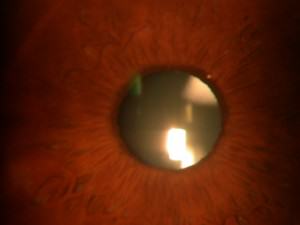Phakic intraocular lens (ICL and toric ICL)
Patients with high level myopia and hypermetropiaThe phakic intraocular lenses are the alternative solution when a patient is not suitable for laser treatment. Although less popular than the well-known laser treatment, this technique has been performed for 18 years and has been authorized by the FDA (Food and Drug Administration) of the US’ government. The FDA does only approves a surgical product after years of study and an exhaustive monitoring in different hospitals, so as to confirm its long-term, great results. At the IOA (Instituto Oftalmológico Amigó) we carry out the implantation of phakic intraocular lens in a regular basis since 2001. The results obtained are the best quality of sight, after a short period of recovery and the highest safety during the process. |
ICL techonology has been internationally approved and accepted.ICL was first developed in the USA by STAAR Surgical Company, a company with an outstanding trajectory in the innovation of ocular technology. STAAR’s product was the first of its kind to be widely recognized by refractive surgeons all around the globe. The ICL is the result of 20 years of research and development, which have led to its gradual improvement and the ultimate achievement of the current model, this having being implanted for more than 10 years. Every year more than one thousand standard ICL lenses are being implanted in Spain for cases of myopia and hypermetropia, as well as the toric ICL for those cases of astigmatism. Finally, its acceptance by the American and European health control systems guarantees its reliability |
The most important details of this technique are explained below, so that you are well-informed to take the right decision.
| FOR MORE INFORMATION CLICK ON EACH QUESTION | ||
|---|---|---|
|
[wpspoiler name=”How does a phakic lens look like?”]The collamer ICL (Implantable Contact Lens) is similar to the contact lens in its form and aspect. The difference lies on its position: the contact lens is on the surface while the ICL goes inside the eye.
It is a smooth, little lens, very much alike to the natural lens of the eye, which it does not replace. That is to say, the implantation of the ICL lens is done while the natural lens is preserved. That is why it is called phakic lens, because it respects the lens. This way, it becomes an additional lens to the ocular system. ICL is designed so as to correct the myopia and hypermetropia when necessary, and the toric ICL (TILC) corrects the myopia with astigmatism. [/wpspoiler][wpspoiler name=”How is it implantated?]Because of its smoothness and little size, the ICL lens is folded and injected behind the iris, going through a small incision made in the external lateral of the eye.Once it is implanted, it is unfolded and accommodated inside the liquid found between the iris and the natural lens, the aqueous humor. This space is known as the posterior chamber of the eyeball, and thus this is a phakic lens of the posterior chamber. The ICL remains stable in this position so that it corrects the sight permanently. This surgery does not need of stitches because the incision is spontaneously closed. [/wpspoiler][wpspoiler name=”How does it feel?”]At the IOA we use topical anesthesia eye drops for the surgery, so that the process is painless even though the patient could feel the contact of the hand or the coldness of the liquid. An anesthetist will sedate and accompany you the whole time in case you feel nervous. The whole process takes no more then 8-12 minutes per eye. [/wpspoiler][wpspoiler name=”Surgery after the age of 40″]After the age of 40, the short-distance sight is naturally affected, implying that the use of reading glasses will be necessary. In cases like the one described, you will be informed about the current surgical options to decrease or avoid this necessity. For more information about the laser treatment of long-sightedness or intraocular lens click here.[/wpspoiler] |
[wpspoiler name=”¿Of what materials is it made of?”]The ICL is made of a surgical material called collamer, whose most important quality is that of being highly adequate for the eye, as it would be a natural tissue, meaning that the lens will not be rejected by the eye.
[/wpspoiler][wpspoiler name=”What are its advantages?”]Among its advantages it permits the correction of myopia, hypermotropia or astigmatism without the need of touching the cornea (for those patients who have been warned of corneal laser or their disorder cannot be corrected with it). Secondly, it achieves a great quality of vision, superior to the results obtained by the laser in the treatment of myopia or hypermetropia. What’s more, it is usual that the results obtained by the phakic lens are superior to the vision quality achieved by means of glasses.
ICL permits a quick period of recovery, often faster than with the laser treatment. Generally the patient can resume its everyday activities the next day after the intervention. The phakic intraocular lens does not require any kind of maintenance and it is invisible from the outside, except for the special equipment of the ophthalmologist.[/wpspoiler][wpspoiler name=”What risks entails the ICL?”]Just like in any other surgical process and life itself, during the intervention and post-operative something could come up. There are innumerable situations possible, but all of them can be easily resolved. What matters the most is that the patient is well-informed so he or she can act accordingly in advance. It is highly important that the patient be monitored by the surgeon once in a year. This is the best guarantee of success for a long-term period. [/wpspoiler][wpspoiler name=”Surgery after the age of 55″]There are more and more patients over 55 years old that are treated at the IOA for refractive surgeries. At this age, the need for reading and distance glasses is at its maximum rate, which is why the implantation of permanent multifocal intraocular lens is often the best option for patients over 55. These lenses are permanent, which allows the drastic decrease or final elimination of the use of glasses in a secure and definitive way. Thus, there would be no need of using glasses again in the future. For more information, please do read the section on long-sightedness. NOTE: After the age of 55 the laser is unlikely to be used as a technique to dispose with the glasses, while the implantation of intraocular lenses is increasing because of its benefits.[/wpspoiler] |
|
An Ideal solution for every problem
Taking into account that every person’s eyes are different, the ophthalmologist must choose the best treatment for everyone. The ICL is useful when it comes to the correction of common refractive problems, as well as to those cases whose treatment with conventional laser is not advisable. For instance:
|
|
Frequently Asked Questions
| FOR MORE INFORMATION CLICK ON EACH QUESTION: | ||
|---|---|---|
|
[wpspoiler name=”Would I be a good candidate for ICL treatment?”]
The best candidates are those between 24 and 50 years old with myopia or hypermetropia with or without astigmatism. The best candidate is that with no medical record of glaucoma, iritis, diabetic retinpathy and others. A complete ophthalmologic test is essential to confirm if you are an electable candidate. [/wpspoiler][wpspoiler name=”What advantages has the ICL?”] The ICL can correct a wide range of problems related to myopia and hypermetropia with or without astigmatism and there is no need of operate the tissue of the cornea (what the laser treatment does). The ICL is a foldable, tiny lens that is inserted through a small incision of 3mm that does not require stitches. The ICL produces an ideal vision and the results are highly foreseeable. This is so because of the position it adopts inside the eye and the high optical performance of the lens. The ICL is made of collamer, a unique and complete biocompatible material. [/wpspoiler][wpspoiler name=”What would happen if any changes occur to the vision of the patient?”] If any changes would occur, the ICL can be removed and changed for other lens easily. Another type of treatment could as well be done at any time, such as add a correction with laser where a phakic intraocular lens has been previously implanted so to adjust the result. With the ICL is possible to use glasses or contact lenses, if necessary. The ICL does not directly correct presbyopia (long-sightedness). That means, after the age of 40, it is more probable that the patient needs glasses even if he or she has a ICL. There exist other alternatives to avoid this in the election of the ICL.[/wpspoiler][wpspoiler name=”Might the ICL get dirty or dry as it happens with contact lens?”]
No, the ICL has been designed to remain inside the eye without the need of any maintenance. It is very important that an annual visit to the ophthalmologist is done in order to be sure that everything is all right |
[wpspoiler name=”It is possible to see the ICL?”]
No, because the ICL is located behind the iris. It goes unnoticed to those wearing it and any other person. The cosmetic results are then excellent.
For those not trained professionally would never guess that a person has been implanted an ICL on the eye. ICL is not seen. Optical part of a phakic lens implanted in the IO in 2001. Just its reflect on the microscope reveals to the ophthalmologist its stable position behind the iris, remaining invisible to the naked eye. Later, the patient will receive a treatment with eye drops and perhaps any oral medicine. Usually it is recommended to go back to the clinic a few hours or a day after the operation to monitor the patient. The patient will be accompanied by an anesthetist at any time, so that if he or she needs sedation, it will be provided. For more information about the correction of the phakic lenses do not hesitate and contact us for an evaluation at the IOA. [/wpspoiler] |
|


